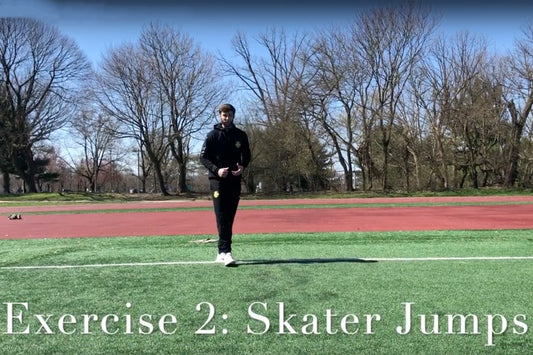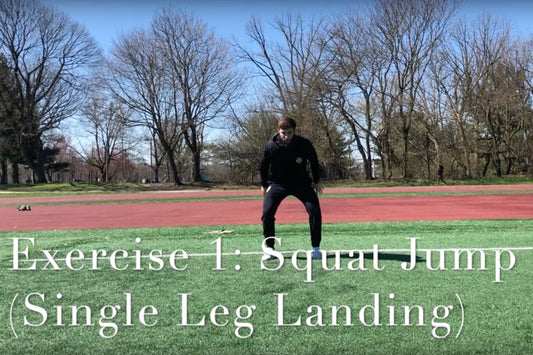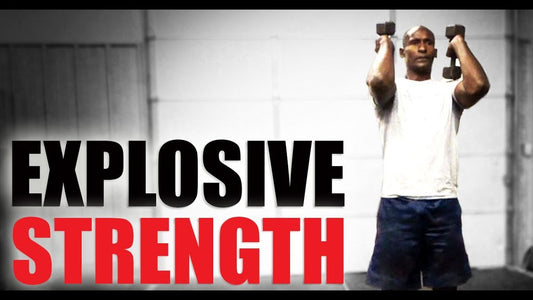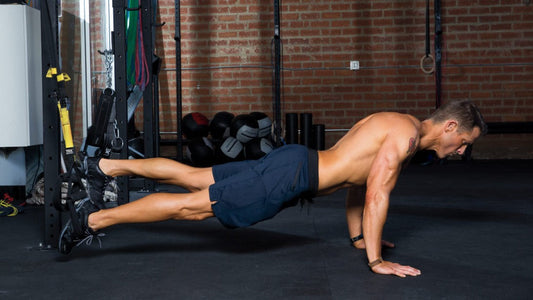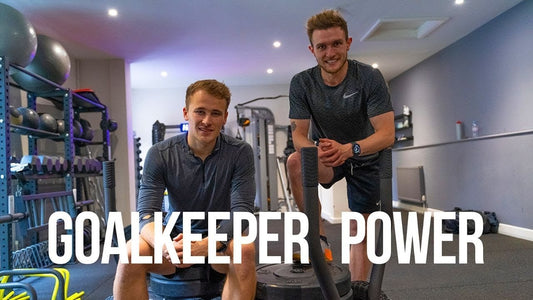Strength & Conditioning
Advanced Plyometric Exercises for Soccer Goalkeepers
If you’re reading this, you’re either an advanced goalkeeper or you made it through the beginner portion of this series; either way thank you for stopping by. In the beginner portion of the video, I emphasize the importance of our landing mechanics pretty frequently. That remains true in this section, however there’s just an added challenge to it. That challenge is being able to comfortably land on one foot.
Almost all of the position is played off one foot. Kicking, diving, sprinting, etc. so shouldn’t we be able to do move athletically off of one foot. The following exercises are all in here because of the single leg component it provides. These exercises are all in here to help improve our first step acceleration, explosiveness and much more. Have a look and try them out!
Exercise #1: Squat Jump with a Single Leg Landing
It is assumed at this point, we are comfortable landing with proper mechanics. The squat jump is a phenomenal exercise to help build muscle endurance in our whole lower body. Too often, we go up for a cross, get bumped and are then forced to land awkwardly on one leg, increasing our chance of injury. While this exercise doesn’t necessarily imitate us getting bumped, it preps our body to land comfortably one one foot.
Exercise #2: Skater Jump
If I had to choose a favorite plyometric exercise for goalkeepers, this would be it. Listen to the explanation in the video and that explains why I love it. The name of the exercise implies hockey, but couldn’t be better for goalkeepers..Let’s just change the name to Keeper Jumps why don’t we?
Exercise 3: Alternating Lunge Jumps
Lunge jumps will have your legs firing!! When we think the position of goalkeeper and the demands it asks of our body, a lot of emphasis can be placed on the glutes. Lunge jumps are the perfect exercise to help build that strength and endurance in our glutes. Not to mention the added core stabilization component to these.
Exercise #4: Single Leg Broad Jump
As mentioned in the “beginner” portion of this, broad jumps are an absolute incredible measuring tool for force production. Now, adding the single leg component makes it twice as good. In the video, I explain why I value these exercises so much in through ball and 1 v 1 scenarios. A great exercise to improve acceleration, which is one of the most important physical characteristics of a goalkeeper.
Exercise #5: Single Leg Bounds
Bounds have been used in the track & field region for quite some time to improve sprint speed and acceleration. Just so happens that our position requires us to be quick off of our line to save the day. The single leg bounds allow us to continuously produce force which can increase our speed & power to help save the day.
Jesse Goleman is the owner of Goleline; a strength & conditioning company designed to cater specifically to the needs of goalkeeper. More information can be found by following Jesse on Twitter and Instagram @goleline
5 Plyometric Exercises to increase goalkeeping strength
When most people think of the goalkeeper, they think of that amazing top corner save that garners all of the highlights. But, what people may not think about is the steps it takes to be able to make that save. As goalkeepers, we’re not always called upon often; but when we are called upon to make that save, we need to be ready.
Goalkeepers should be able to make quick, rapid movements to either sprint forward, make a save, come for a cross etc. But sometimes, it’s hard to know what to do to train to increase that explosiveness and power developed from the ground.
Goalkeepers need be comfortable jumping, diving and landing on both feet. The exercises below are set to help you achieve new heights (pun intended) on the field! Take a look!
Beginners
Exercise #1: Drop Squats
I go into detail about why these exercises are the first one on the list. While it may not seem like much of a “plyometric” exercise, the importance of mastering this exercise will carry you through these drills. “Absorbing our body” is a term commonly referred to. Landing produces more force than when we jump, therefore adding a very necessary component in being able to decelerate properly to help us avoid injury.
Exercise #2: Line Jumps
Line jumps are commonly used throughout all sport..for good reason. This is a very low impact plyometric drill but one that will strengthen the ankles and calves tremendously. That will be very important, especially for young goalkeepers when talking injury prevention. After being comfortable on two feet, add the challenge of only using one foot. Reap the benefits from consistently adding this exercise in to your routine.
Exercise #3: Squat Jumps
Ahh finally, now were talking explosive movements. The squat jump is another very common exercise used across sports. With the squat jump, we start getting in to more jumping and landing mechanics. Our goal for this is to jump as high as we can off the ground while still being able to land properly back in our start position. (See the advanced version for progressions).
Exercise #4: Knee Tuck Jumps
Similar to the Squat Jumps, this just forces us to produce a little more force, which will hopefully increase our power. Bringing our knees up a little bit higher creates more of a challenge because it is us essentially jumping higher than a typical squat jump. As always make sure we’re landing properly and “absorbing out body”.
Exercise #5: Broad Jumps
When you initially think broad jump, it’s hard not to think of the NFL Combine. BUT, the NFL wouldn’t use it if it weren’t a good measuring tool. Broad jumps are a pure power plyometric exercise. An exercise that can be a great measuring tool for beginner goalkeepers to test their explosiveness. The broad jump is a great measurement to see how much force we can produce jumping and landing. (See the advanced version for progressions)
Jesse Goleman is the owner of Goleline; a strength & conditioning company designed to cater specifically to the needs of goalkeeper. More information can be found by following Jesse on Twitter and Instagram @goleline
Power and Explosiveness for Goalkeepers
At times, goalkeepers must step outside their goal mouth in order to improve their play inside of it. With a great amount of time focused on skill specific training, most keepers have physical deficiencies that prevent them from reaching their peak performance level. Goalkeepers need a strength and conditioning program with challenging total body balance, explosive movements, and measurable goals. Strength and conditioning cannot however, be done sporadically and unsystematically. The goalkeeper must be committed to a program and follow it precisely to reap the highest rewards.
The demands of a goalkeeper are much different than that of a field player. This means the goalkeeper must train differently. Focus must be on improving the areas that are most important and are utilized during the game; power.
In order to increase power one must consider how the muscles and tendons work. There are three phases that occur during an explosive movement such as jumping: first, the muscle lengthens (eccentric phase), followed by a slight delay of time (transition phase), and finally, the muscle shortens or contracts (concentric phase). During the eccentric phase the muscle begins to store energy; during the transition phase a message is sent to the spinal cord then a message is sent back to the muscle; and lastly during the concentric phase the stored energy is released and the desired movement is performed.
To think of the action more practically, one should visualize a simple squat jump. The eccentric phase is the initial downward squat, the athlete hitting the bottom is the transition phase, and when he or she pushes up to jump, the concentric phase takes place.
Plyometrics are not primarily for the lower body, but they can also be used for abdominals and upper body. Goalkeepers must be the quickest player on the field to twist their core or drive their hand out to make a save; therefore we must train these muscle groups in an explosive manner. Often times, coaches make the mistake of training only the lower body, missing these other vital areas.
It is important for the athletes to have a solid strength base prior to starting a plyometric program. Although there is no defined age to start a program, the goalkeeper should be emotionally mature enough to listen to instructions and perform the exercises. I have trained goalkeepers as young as 10 years old with low intensity plyo’s, such as jumping rope, agility ladders and line footwork.
The athlete should be careful not to over train with plyometrics - frequency, recovery time, volume, progression, and the population must be considered. The following are general plyometric protocols for the post-pubescent high school keeper:
Performing one to three sessions a week is sufficient.
The work to rest ratio should be roughly 1:5, meaning if the work is for 10 seconds the rest should be for 50 seconds.
Aerobic work is not the goal, but rather generating as much force as possible on each repetition.
The intensity of the workout is greatly dependent upon training status. A well-trained athlete with an extensive strength and conditioning background will be able to perform higher intensity workouts than a less-trained athlete. For example, a goalkeeper who has completed a twelve week strength and conditioning program will be able to perform plyometric exercises using one arm or leg as opposed to two. They will also be able to perform jumping movements over a specified distance, as opposed to jumps in place. Obviously the younger the goalkeeper, the lower the volume, intensity, and number of sessions.
In order to see improvements, the athletes must increase the demands of the plyometrics they are performing. This is called progressive overload. The intensity of the plyo’s should go from less, to moderate, to high. However, the volume should not increase at the same rate. An example of this could be performing 10 clap push ups with two knees on the ground, and increasing the intensity to doing 10 clap push ups with toes on the ground. The intensity of the exercise increases because it is more difficult by not having the knees on the ground, however, the volume does not increase.
Below is an example of a low-moderate plyometric workout.
Exercise Sets/ Reps Rest
1.) Skipping for height 4 x 25 yds walk return2.) Squat Jumps 2 x 10 1:303.) Lateral Hurdle Hops w/ pause 1 x 10 1:304.) Ankle Poppers 1 x 30 sec
Written by Strength and Conditioning Coach Ryan Carr.
5 Super Circuit Routines for Goalkeeping Strength
Too often coaches do not have a plan that extends beyond the present goalkeeper training session. It is imperative that we move away from this style of coaching and add some science to what we are doing.If I was to go and view most GK sessions what do you think I would see? In my experience the session will concentrate predominately on the technical aspects of the position and little time is given to specific physiological, psychological or tactical requirements. Thus, our GK’s never improve their physiological status to the standard that is required. The natural athlete will survive but the non-athletic GK never maximizes their potential. Firstly, let’s look at the major physiological requirements again:
• Strength• Speed• Stability• Power• Agility• Coordination
Do you know how to train these components and are you presently training them? Too often coaches try to improve speed, power and agility by doing speed, power and agility drills. You may be thinking “yes isn’t this correct” but I want you to think about what is the foundation of these components? Obviously the foundation is strength and in my experience strength is one of the most misunderstood and wrongly trained components of fitness. When coaches think strength it’s about weights with little functional component or the GK is doing so much technical training that there is no time to incorporate a strength program.
Strength training should be completed 2-3 times/week (48hrs between workouts) and should involve a full body program that involves functional exercises. I am a strong believer in bodyweight exercises and am adamant correct technique is followed. Bodyweight routines can be incorporated into the GK session and can be performed at the start of the session and may include:
• Walking Lunges• Bodyweight Squats• Push ups• Chin ups (assisted if necessary)• Core exercises (Russian twist/cycle crunches etc)
No equipment is required and can be completed in a circuit format (3 rotations of 8-12 reps). Progression is an integral part of any program so manipulations can be made by using medicine balls, bands or slowing down the speed of contraction. As time progresses other strength training methods can be incorporated but it is most important that the movements are functional and you do not make this mistake of prescribing a strength training program that has its foundations in bodybuilding rather than sports conditioning. Strength training must be part of every GK’s overall program.
Written by Dr. Craig Duncan, an international expert in goalkeeper development.
Speed, Strength, and Power for Todays Goalkeepers
One of the many outdated theories in American soccer culture is to place the tallest player on the team in the goal. This thinking pervaded soccer fields in decades past, but as soccer exploded in this country and more and more athletes joined the game the tallest athlete is no longer the only goalie traversing the eighteen-yard box. Today’s keepers come in all shapes and sizes, but what elite level keepers have in common is a tremendous athletic ability. No matter how tall an individual may be what will set them apart in the goal are their agility, explosiveness, and strength. Any goalie will tell you that it is not the high shot that is the hardest to save but the knee high blast to a corner, where quickness and explosiveness really come into play. It is these qualities, quickness, explosiveness and strength that coaches are looking for out in their keepers.
To reach this top level, training and conditioning must be stressed. While keepers do not do a large amount of running on the field, they are the player that has to be the most conditioned and focused. When fitness is lacking, physical and mental mistakes occur. During a game keepers have to be constantly involved, positioning themselves and their defense and instantly ready to make a save when the opposition is in their end of the field. This requires a goalie to be in top shape and as explosive as possible. In the 90th minute of a game a keeper must have enough endurance to stay mentally focused to come up with the game winning save.
The time to condition and make gains in speed, power, and strength is during the off-season and pre-season. For many soccer players this is a hard time to distinguish due to the year round schedules many play. Usually the off season falls over the winter when there are fewer games and practices, and the preseason comes a couple months before a main competitive season begins. Taking steps to condition during these times will help prepare a goalie for the rigors of an upcoming season and help to prevent injuries. Strength, agility, and plyometric (Jump) training should take place two to three times a week during these periods. Throughout a player’s main competitive season, depending on the demands of their schedule, it is a good idea to condition one day a week to maintain strength and power. It is always recommended to work with a trainer or at a strength and conditioning facility to make sure that exercises are done with proper technique, especially strength and plyometric training. If you can’t find any way to get to a trainer, don’t be put off if. There are ways to effectively train on your own. Below is a sample work out that focuses on agility, power, and strength that can be done on your own and will help any goalkeeper increase their conditioning and explosiveness. Alternate between the two days to keep workouts fresh and to cover all areas of fitness.
(This article and the training techniques are suggestions. Always consult a doctor to find out whether this type of physical activity is appropriate for you. )
Day 1
x x x x x x x x x = cones or any kind of marker about 2ft apart (Don’t have cones use pieces of tape. Nothing that you can land on and roll an ankle)
*Go through each exercise twice before moving to the next in the sequence
Agility
Steps Quick Feet
Right foot steps first
Left foot steps first
Steps Quick Feet Lateral R/L
Forward Shuffle
Backward Shuffle
Lateral 2 Feet In – 2 Feet Out
Forward 2 Feet In – 2 Feet Out
Backward 2 Feet In – 2 Feet Out
Plyometrics (Control yourself in the landing by being light on your feet)
2 Feet
Quick hops
Jumps Knees to Chest
Quick Lateral Hops Right/Left
Jumps Knees to Chest Lateral R/L
Quick Side to Side Hops
Jumps Knees to Chest Side to Side
Same Sequence 1 Foot Right and Left
Day 2
Warm – Up 20 yards with jog backSkipBackwards SkipShuffle Right/LeftCarioca Right/LeftShuffle Forwards/BackwardsHigh Knee RunButt Kicks
Agility
Start ------------------------------------>x x x x x
x x x x
Facing ConesShuffle ForwardsShuffle BackwardsCarioca ForwardsCarioca BackwardsSprintBackpedal
Facing SidewaysBackpedal to SprintSprint to Backpedal
Strength 3 SetsBody Weight Squat x 20Vertical Jump x 12Push – Ups x 15Burpees x 12
3 SetsLung Walk x 20 yardsSit-ups x 25Single Leg Lateral Bounds 20 yards x 3Russian Twists x 20 each side
*Increase Sets and Reps to progress through the work out and make it more challenging.
Meredith Stewart, MS, CSCSCompetitive Athlete Training Zone Performance CoachNortheastern Women’s Soccer Asst CoachNSCAA Advanced Regional License

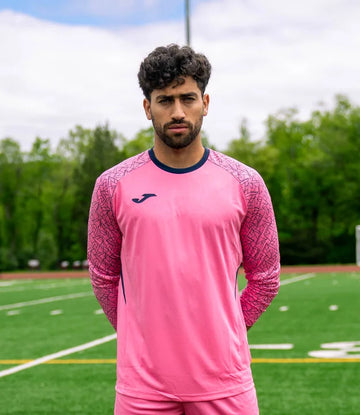
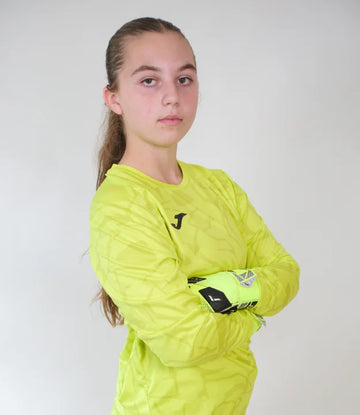
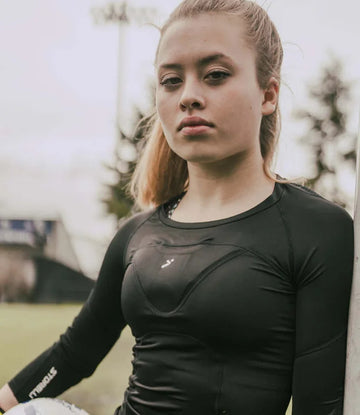
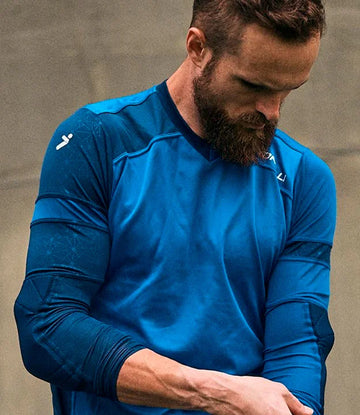
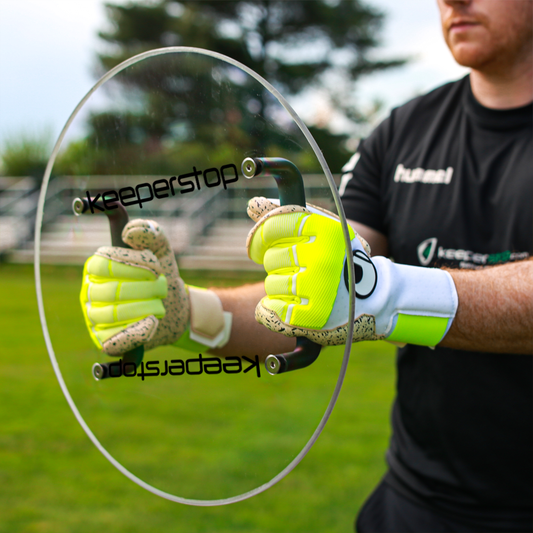
 Gloves
Gloves
 Jerseys
Jerseys
 Gear
Gear
 Brands
Brands
